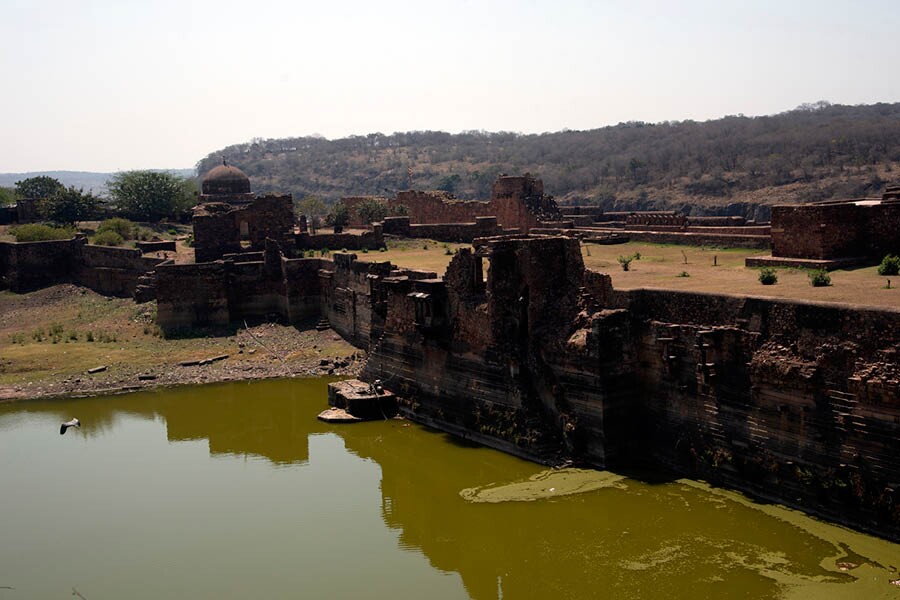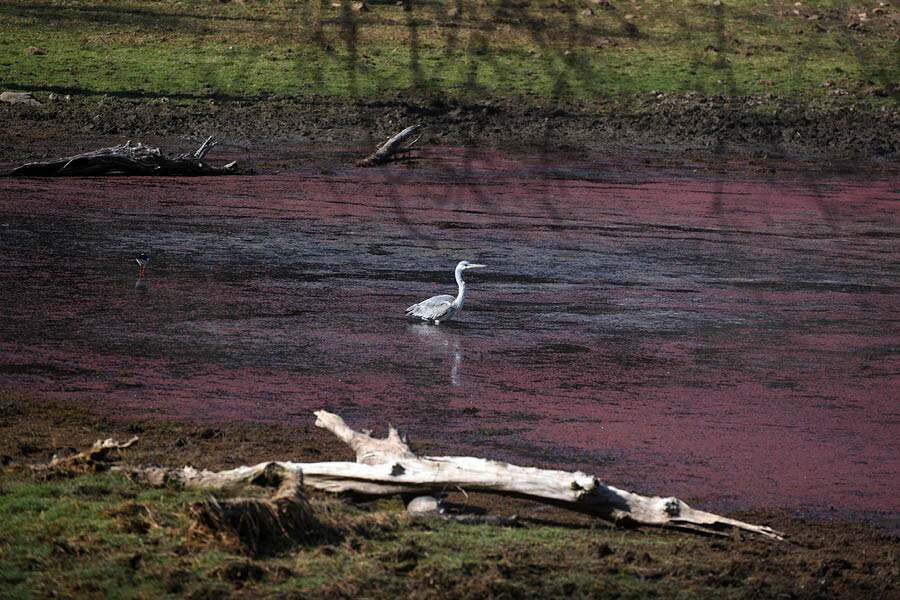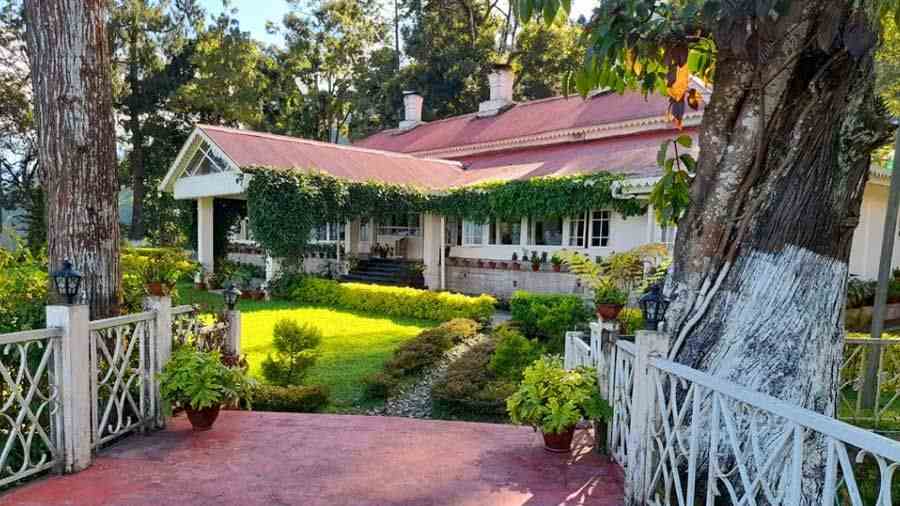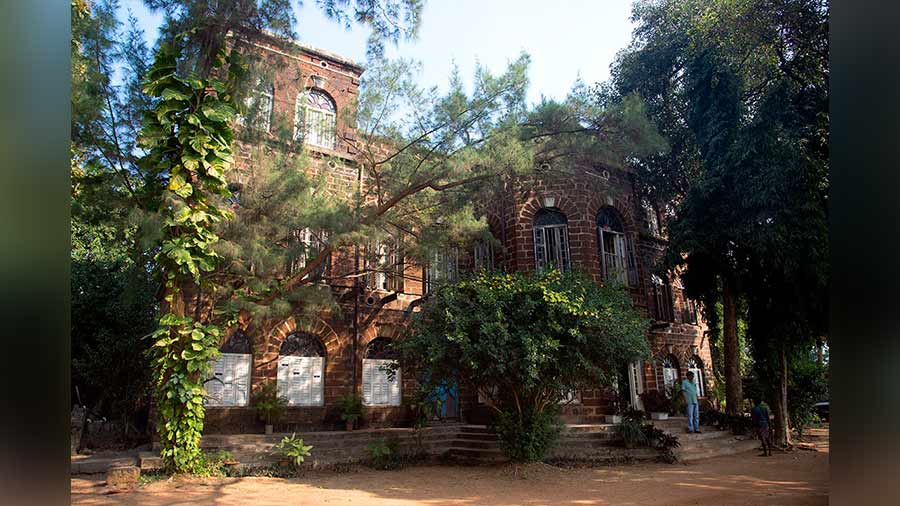The predominantly dry deciduous forest of Ranthambhore, sprawling across 392sqkm and situated around 180km southeast of Jaipur, is widely known as India’s tiger capital. Home to an estimated population of 88 Bengal tigers, big cat sighting is almost guaranteed on a safari through the forested hilly terrain dotted with meadows and picturesque lakes.
I had no such luck though. During the three safaris spread over misty March mornings and warm, sunny afternoons, we spotted herds of gaurs basking in the diffused morning light, families of langurs in playful moods on flowering palash trees and a couple of monstrous crocodiles lying motionless, their jaws open, on the muddy banks of an oval-shaped lake.

A lone spotted deer in the mellow afternoon light
Chasing the elusive tiger on the trail of his pugmarks (our guide informed it was a dominant male), we discovered some hidden treasures of Ranthambhore such as the iconic Jogi Mahal – the historic hunting lodge of the maharajas of Jaipur - perched on the edge of Padam Talav, the rusty-red façade of the 19th century structure resplendent with its rippled shadow on the lake’s clear waters. We marvelled at the other-worldly pink surface of a small waterbody that seemed to be the home of a wide variety of a species of birds. “Possibly, the presence of the fern that lends this unusual colour to its water attracts the avian fleet to this lake,” Nadeem, our guide, said.

The ruined walls of Ranthambhore Fort
Back at Bookmark Resorts, Jogi Mahal, our three-day base at Ranthambhore, we were in for a couple of pleasant surprises. As darkness gently descended on the expansive lawn decorated with an ornate, vernacular stepwell, a group of musicians enthralled us with a musical session of folk instruments, an orchestrated symphony that perfectly blended with the earthy charm of Bookmark Resorts.
After the musical soiree, we had a guided stargazing session. We gathered around a powerful telescope and took our turns to embark on a unique astronomical safari, marvelling at the wonders of a clear, star-studded desert sky. “This is an ideal place to spot celestial wonders such as the Saturn’s ring and Jupiter’s satellites, and also interstellar objects,” said Sanjay Singh Ranawat, the resident astro-guide of Bookmark Resorts.

The fort-like facade of Bookmark Resorts, Jogi Mahal
Our next day in Ranthambhore was woven around two unique cultural excursions. In the morning, we attended a workshop of M.D. Parashar – the legendary wildlife artist who works with the unique medium of soot powder to create stunning black-and-white, jungle-themed artworks on paper. With lampblack as ink and a precisely folded newspaper used as a nib, Parashar’s soot paintings have now attained a cult status and two of his works now adorn the walls of the Rashtrapati Bhavan and the White House.
After indulging ourselves into the decadent delights of a lavishly curated Rajasthani thali at our resort, we set off to Shyamota village, about 20km away. The hamlet is renowned for Ranthambhore black pottery, one of the highlights of Rajasthan’s rich repertoire of folk art. The craft had originated many centuries ago and over time the traditional designs and motifs have been elegantly fusioned to bring out contemporary twists to this ancient art.

A soot painting by MD Parashar
Shambhu Prajapati, an artisan who now carries the legacy of Ranthambhore black pottery, showed us around his workshop where doughs of iron-rich clay metamorphose into shapes of everyday utensils, birds, animals and even free-flowing abstract forms though a series of long and meticulous manual procedures.
From Shyamota we drove back to Ranthambhore Fort. A steep flight of stairs from the parking lot took us right up to the huge gateway of the 10th century fort, now ascribed UNESCO World Heritage status. We passed through a series of majestic archways, wandered aimlessly through the stone-paved pathways and marvelled at the palaces and pavilions – once the bastions of a formidable kingdom – now lying in dilapidated ruins.

One of the many water bodies of Ranthambhore, this one is characterised by its vibrant pink surface
At the end of the fort tour, our guide, Nadeem, steered us to the edge of the rampart. The sheer walls of the fortress tumbled down to the edge of the forest. A mellow desert sun prepared to end another day over the horizon. In the gathering darkness, the forest of Ranthambhore rolled out below us, sombre and deeper in the fading light.



